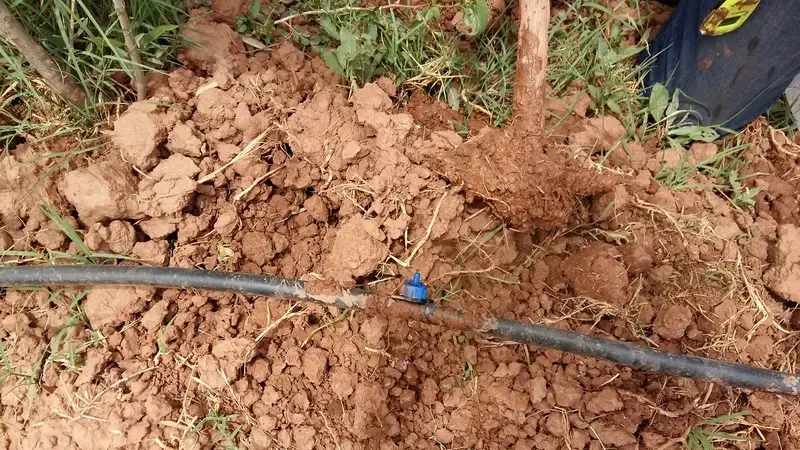Pioneering ultra-low energy irrigation as a climate-smart technology

By Vinay Nangia
Declining precipitation and water scarcity make irrigated agriculture increasingly crucial to the economy and social well-being of farmers in dry areas. This is also the case in Morocco, where ICARDA develops technologies to promote sustainable use of natural resources. Today, most irrigation schemes in the Middle East and North African region are based on surface methods, often resulting in significant water losses.
Drip irrigation, however, has proved to be a promising climate-smart technology solution as it promotes natural resource management and water conservation.
Off-grid challenges
The challenge is to find ways to increase the use of drip irrigation methods in rural areas where farmers largely remain without access to electricity. While drip irrigation can aid in rural poverty alleviation, many smallholder farmers in the least-developed dry areas are off-grid. This results in high costs of system implementation and operation, preventing large-scale adoption. In particular, the energy and pump capacity required in off-grid systems make up the majority of these costs.
With this in mind, the Massachusetts Institute of Technology’s Global Engineering and Research Lab has developed a new dripper named Ultra-Low-Energy or ULE Drippers that requires a fraction of the activation pressure and energy to operate when compared with traditional and commercially-available drippers. This has allowed for testing the use of solar panels to power the ULE Dripper technology.
Halfway through the four-year project launched by ICARDA in 2016, there are solid indications that show this technology’s benefits.
Reducing energy consumption by half
The newly-designed ULE emitters will cut pumping energy by 50%, enabling drip systems to run on low-pressure municipal water supplies, while maintaining satisfactory system uniformity and performance. Such technology would increase access to drip irrigation and facilitate scale-up in the MENA region’s rural areas, to the benefit of smallholder farmers and national economies that rely heavily on agriculture.
The objective of the Ultra-Low Energy Drip Irrigation for MENA Countries project (2016-2020) is to design and test ULE drip irrigation systems for the MENA region. Field trials are taking place in Morocco and Jordan. In Morocco, the project is implemented jointly by MIT and ICARDA, in collaboration with the Institut National de la Recherche Agronomique, Jain Irrigation Systems, and the US Agency for International Development.
Morocco’s Green Plan and the ULE project
Through the Green Morocco Plan -- Plan Maroc Vert -- the government of Morocco launched a massive drip irrigation dissemination program named “Programme National d’Economie d’Eau en Irrigation” around 10 years ago to reach approximately half the country’s irrigated areas. The program included the installation and large-scale conversion of inefficient irrigation systems to drip irrigation over a 15-year period with conversion of about 555,000 hectares from surface to drip irrigation. It also aimed to reach areas where communities are off-grid and the need for new solutions are essential to improve the livelihoods of rural populations.
In Morocco, Phase I of the ICARDA project investigated the performance of ULE drippers using a system connected to the electricity grid. The INRA Saada Research Station and farms near Marrakech tested the technology on young and mature olive orchards. Sites at the Beni Mellal INRA Research Station conducted field trials on young and mature citrus orchards.
Extraordinary results
Preliminary results were promising, with system uniformity from ULE drippers performing well and comparable to traditionally-used drippers, while showing significant energy savings. Some sites reported approximately 70% savings in cumulative hydraulic energy per unit volume of water.
Phase II of the Project, launched in Morocco in February 2018, saw the implementation of an off-grid solar-powered drip irrigation system at the Saada INRA Research Station. With the use of two solar panels (maximum power rating of 270 W/panel), the entire 0.5 hectare plot could be irrigated using ULE drippers and a solar pump set at just 0.35 bar (compared with 1.0 bar for conventional pump for such size plot). It showed potential for significant energy savings and future technology scale-up.
Reaching out to farmers
ICARDA and INRA organized A Farmer Field Day to disseminate knowledge to farmers and foster their interest. Small-scale installations of ULE drippers on selected Moroccan farmers’ fields are taking place. An in-line solar-powered ULE drip irrigation trial on vegetable and cash crops at the INRA Agadir Research Station in January 2019 will show widespread potential applications of the technology beyond orchards.
We need to increase access to drip irrigation technology in least-developed and off-grid dry areas of Morocco and other MENA countries. This will have tremendous effects on the region’s agriculture, economies, and environment.
The author is agricultural hydrologist at ICARDA.
